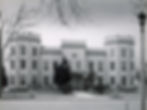About Bayside Historical Society
Our Mission
Bayside Historical Society was founded in 1964 to collect, preserve, and disseminate information concerning the history of Bayside, Queens, and its adjacent communities; advocate for the preservation and protection of its most historic structures and distinctive neighborhoods through the landmarking process; and strive to develop a broad constituency of like-minded preservation and educational organizations to protect the historic integrity of our communities and collections.
Our History
The birth of the Bayside Historical Society was the culmination of several committees initiated by its founder, Joseph H. Brown. His aims were the beautification and protection of the environment and community in which he lived, and awakening civic pride in Bayside’s long history. In 1964, with Brown’s leadership, the Society was officially founded by a small group of like-minded residents with three goals: The preservation and restoration of the Lawrence Family Cemetery, Alley Pond and Fort Totten.
Since 1984, BHS has been located at The Castle in Fort Totten Park. Built in 1887, the building was originally used by the U.S. Army Corps of Engineers as their Officers’ Mess Hall and Club. The Gothic Revival-style Castle is a NYC designated landmark, and is also listed on the National Register of Historic Places.
Today, Bayside Historical Society serves as a learning destination, a resource for researchers and the community, and a venue for the visual and performing arts.

The Castle
Between 1880 and the first decades of the twentieth century, permanent structures replaced the temporary wood frame buildings erected on the Fort at Willet’s Point in the 1860s. New construction included family housing, barracks, a hospital, offices, storerooms, laboratories, workshops, a fort museum, YMCA and a theater. Virtually all of the buildings constructed during this period have survived. Among them, arguably the most distinctive structure is The Castle, and is one of the finest surviving examples in New York City of the Gothic Revival castellated style architecture. Perhaps the greatest significance of The Castle is the direct architectural tribute it pays to the emblem of the U.S. Army Corps of Engineers, who centered most of their activities at Willet’s Point from 1866 to 1902.
Completed in 1887, the building served as the base Officers’ Mess Hall and Club for the U.S. Army Corps of Engineers School of Application. The School of Application had been established at Willet’s Point on an unofficial basis after the engineers left West Point in 1866. It was granted formal status as the Army’s post-graduate school in military engineering by Secretary of War, Robert Todd Lincoln, son of the late President, following a tour of inspection in 1884. The Army Engineers only used the building for 15 years. In 1902 they moved personnel and materials, to Washington Barracks at the Nation’s Capital. Following the departure of the Corps, the building remained in use by the Army for the next 65 years during the intense activity of two World Wars. From 1970 to 1974 the building was a New York City Job Corps Center, and was designated a New York City landmark on September 24, 1974. When the Job Corps relocated, it stood unoccupied for over ten years.
In 1986 The Castle was placed on the State and National Registers of Historic Places. By that time, the Bayside Historical Society had undertaken the responsibility of restoring it and The Castle has become home to BHS events, educational programs, exhibits, and archival collection.

The Castle was initially painted white but by the beginning of the 20th century, the exterior was changed to scarlet with white trim in order to reflect the Corps’ official colors.

The Castle's second major exterior restoration campaign was completed by 2006.


The Castle was initially painted white but by the beginning of the 20th century, the exterior was changed to scarlet with white trim in order to reflect the Corps’ official colors.
Lawrence Cemetery
The Lawrence Cemetery is located in a wooded area at the corner of 216th Street and 42nd Avenue, in Bayside New York, a site once prized by the Lawrence family as a favorite picnic ground called “Pine Grove.” The property was part of the original land deed granted by Governor Willem Keift of New Amsterdam in 1645 to John Lawrence (1618–1699). The site is now maintained by BHS.
In the cemetery, a variety of headstones mark the final resting place of forty members of the Lawrence family, their descendants, and heirs. The first burial took place in 1832 and the last in 1939.
Members of the family who are buried at the cemetery include Cornelius Van Wyck Lawrence, Mayor of the City of New York (1834-37). His grave is marked by a shaft in the form of an obelisk. County Judge Effingham Lawrence’s gravesite is designated by a rectangular stone, set on a stepped-up base. Other members of the Lawrence family interred here include Colonel Frederick Newbold Lawrence who served in the Civil War and was later president of the New York Stock Exchange from 1882 to 1883, and Mary Nicolls Lawrence, second wife of Mayor Andrew H. Mickle of the City of New York.
The New York City Landmarks Preservation Commission designated landmark status to the Lawrence Cemetery on August 2, 1967.
The Bayside Historical Society provides guided tours of Lawrence Cemetery annually, sometimes featuring theatrical performances where actors portray the individuals interred there.




